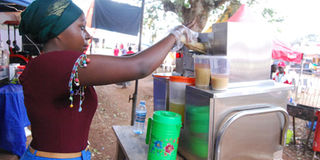Namuli finds a gold mine in cane juice

What you need to know:
- Inspiring. Farmers in areas without sugar mills can now grow sugarcane not for the sugar, but for its juice. Mariam Namuli has demonstarted that.
- She extracts juice from the cane and mixes it with flavours from other substances to create a healthy drink.
The 26th Source of the Nile Agricultural Show which ended yesterday in Jinja District could not have come at a better time for Mariam Namuli.
The 22-year-old graduate of Human Resource management from Islamic University in Uganda (IUIU) made a killing from selling sugarcane juice to revelers at the annual showpiece.
Starting out
Tired of job-hunting in Kampala, Namuli in March went to visit her brother in Brazil and has since never looked back.
Noteworthy, Brazil currently tops the list of sugarcane producers in the world, with an annual production of 739,300 thousand metric tons and the South-Central region accounting for more than 90 per cent of this national production output.
“When I got to Brazil, I found that sugarcane growing was booming and many people were making a decent living off selling sugarcane products and home-made confectionaries,” she said.
Adding: “My brother then advised me to start something up back home; and with capital of Shs20m, mainly from him, I bought this machine and started making sugarcane juice about three weeks ago.”
“At first I was skeptical on whether the business would succeed since I have heard of businesses collapsing in its infancy. But after people started asking for the juice while claiming they were fed up of chewing the actual sugarcane, I was motivated to pursue this business further,” she said. She has branded her product Mozzy Express Sugarcane Juice.
Turning point
Namuli’s windfall however came when she was invited to showcase her products at the Buganda cultural expo that run from June 24 to June 30.
She recalls: “Here, I made Shs500,000 per day making a total of Shs3.5m during the week-long event.”
“The response was immense; people sought to drink the sugarcane juice, claiming they were tired of eating sugarcane,” she says.
Juice-making process
After harvesting, the cane is washed and peeled then it is passed through an extractor that crushes and spins it to remove the juice, which is then mixed with a little water and flavours.
A half metre length cane can be produce up to two litres of the raw cane juice, which can be refrigerated for storage, as with other juices.
Also, apart from the flavours, cane juice requires no additives or preservatives.
“After extraction, cane juice can be flavoured with ginger, lemon, cinnamon and other substances that are readily available and it produces a very healthy drink,” Namuli said.
The extraction of juice from sugarcane will go a long way in enhancing value addition for sugarcane.
Namuli explains that it only takes her two minutes to make a three-litre jerry can of cane juice.
“I start by peeling about five average sized local (red) sugarcanes, cut each to about half a meter long and then pass it through the machine,” she says. “The machine shreds it while squeezing out the juice which drips into the container through an inbuilt sieve. From there, I collect it and serve it to customers without adding any sugars. Since it is from sugarcane, there is no need to add any sugar though I add flavours such as ginger and lemon for those who want,” she says, adding that plans are underway to add other flavours such as vanilla, cinammon and apple to the juice.
According to Namuli, the sugarcane can be shredded and squeezed with the peels on, describing it as ‘more nutritious’ but understands her customers’ needs whom she says are used to first peeling the sugarcane before eating it. “(The juice) is very nutritious because no component is removed from sugarcane when extracting the juice. All the minerals that are usually consumed in chewing cane are maintained,” said Namuli during the Agricultural Show.
As a way of serving her juice cold, Namuli says she occasionally peels the sugarcane and keeps it in a fridge to freeze in some circumstances so that by the time the sugarcane is squeezed into juice, it is cold.
Challenges
Namuli’s most enduring challenges are running out of ‘local red sugarcane’, flies and bees hovering over her product.
The ‘red sugarcane’, she says, is rich in taste and has plenty of juice as opposed to ‘gowa’ (the green sugarcane’). “From just five red sugarcanes, I am able to fill a three-liter jerry can as opposed to about seven to eight sugarcanes of other species,” she said, adding that she currently buys the red sugarcanes from markets in Jinja and Kampala but they become expensive following their scarcity.
“Then, ordinarily, bees and flies like hovering over sweet things. Though customers know that, it is embarrassing when you are in the middle of serving some ‘high-profile customers’ and bees start buzzing around,” she says.
Prices
A half-litre glass of Namuli’s juice goes for Shs2,000 while a 20-liter jerry can goes for Shs200,000.
Since the agricultural show started on July 13, she has been making a profit of Shs200,000 per day. So far, there has not been a distinguished market for the cane juice as this is still a new concept in Uganda but Namuli is determined to soldier on.
She intends to take a loan and bottle her juice. “The market is big. Ugandans love sugarcane. I have approached many people including my family about expanding,” says Namuli .
Way forward
Namuli sees her business as a going-concern and in five years, she expects it to be a big company rubbing shoulders with other Small and Medium Enterprises (SMEs). “I want to grow big and teach people of my age to come up with businesses which are unique and not necessarily require a lot of money. I am earning a living and learning more,” she says.



